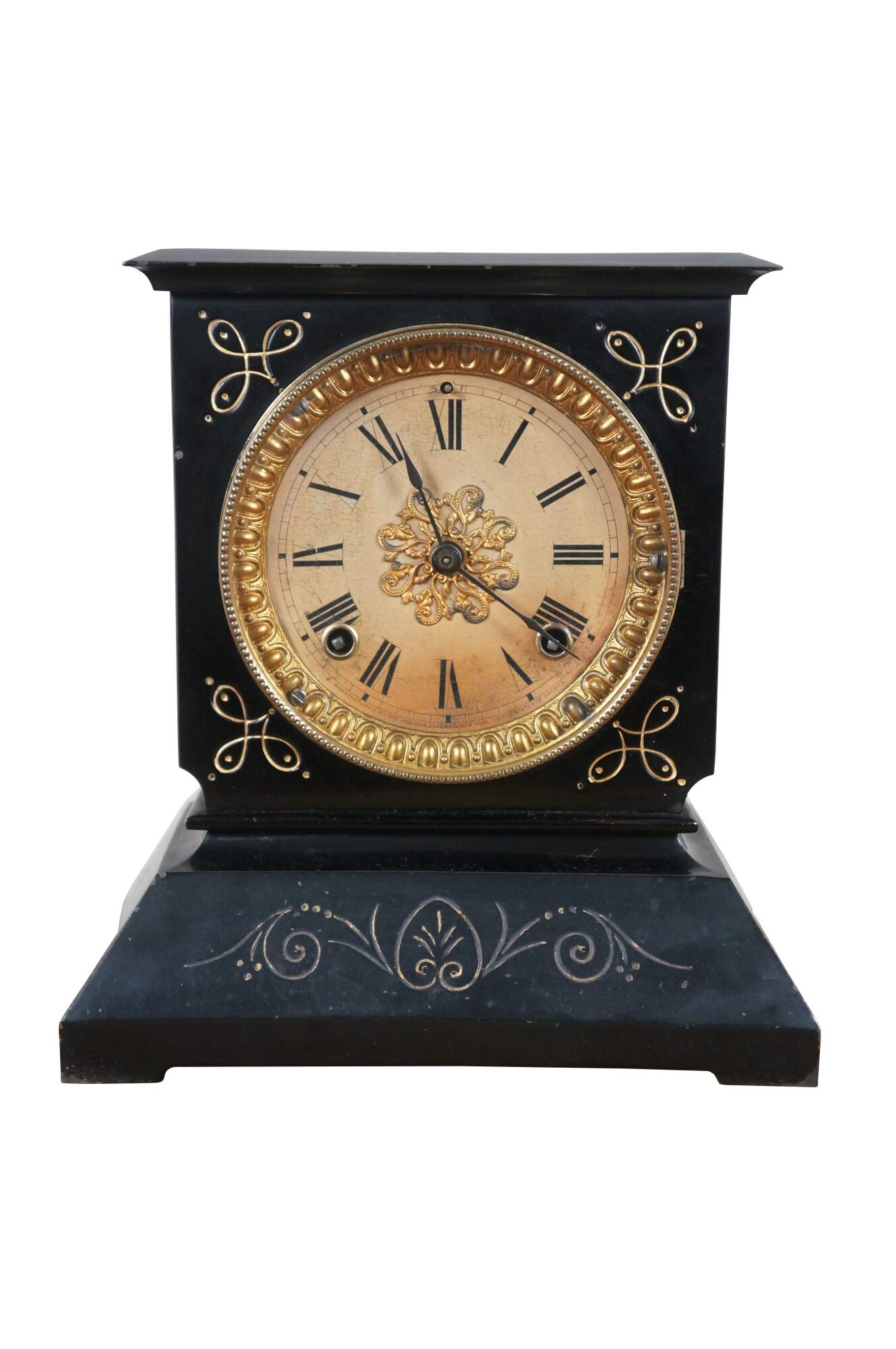
Shipping:
Free Shipping Included
Delivery:
Estimated 2-15 Business Days
Payments:
Credit Card, Check, Cash, PayPal, Apple Pay, Venmo
Returns:
30 Days 100% Money Back Guarantee, Buyer Pays Return Shipping
Description
Late 19th century black cast iron Ansonia mantel clock. Black lacquered iron case with gold painted art nouveau foliate details. Key wound, chiming. Off white face with black Roman numerals and hands; gilt floral filigree medallion and egg and dart frame. Manufactured by the Ansonia Clock Company, New York, United States of America.
The Ansonia Clock Company was a clock manufacturing business founded in Ansonia, Connecticut, in 1851 and which moved to Brooklyn, New York, in 1878. The company has produced hundreds of different clock models, including Gingerbread, Porcelain, and Crystal Regulator styles. The business shut down in 2006. In 1844, metal dealer Anson Greene Phelps formed the Ansonia Brass company in Connecticut, to supply the expanding clock business - nine companies were producing clocks in Connecticut. In 1851 the Ansonia Clock Company was formed as a subsidiary of the Ansonia Brass Company by Phelps and two Bristol, Connecticut, clockmakers, Theodore Terry and Franklin C. Andrews. Terry & Andrews were the largest clock manufacturers in Bristol, with more than 50 employees using 58 tons of brass in the production of about 25,000 clocks in 1849. Phelps decided to get into the clockmaking business to expand the market for his brass, while Terry and Andrews got access to better quality brass at better prices. They had resultantly sold 50% of their business to Phelps, and moved the business to Ansonia after their Derby, Connecticut factory burned in 1854. In 1877 the clock company purchased a factory in New York, and moved most of its production there after being spun off from the brass company. Henry J. Davies of Brooklyn, himself a clockmaker, inventor and case designer, joined the newly reconstituted company as one of its founders. As President, he is thought to have been largely responsible for the figurine clocks, swing clocks and other unusual and desirable novelties for which the Ansonia firm became known. By 1879, a second factory was opened in Brooklyn, New York and by June 1880 employed 360 workers, while the Connecticut factory continued producing clocks as well with a workforce of 100 men and 25 women. Hence, clocks marked "Connecticut" were generally produced before 1879, while those marked "New York" were all produced after 1880. The New York factory burnt down in 1880 - the loss was reported to be $750,000 with only $395,000 insured. The company rebuilt the factory on the same site, and reopened the expanded factory in 1881, with capacity to exceed that of the Connecticut factory - which closed completely in 1883. By 1886, the company had sales offices in New York, Chicago and London, and more than 225 different clock models were being manufactured. The prosperous and debt-free Ansonia Clock Company reported having an inventory worth $600,000 and receivables valued at $250,000. In 1904, Ansonia added non-jeweled watches to their line, and produced an estimated ten million of these by 1929. In early 1914, just before World War I, Ansonia was producing 440 different models. However, the novelty clock became subject to fierce competition. As Ansonia's strongest selling line, rather than maintain profit, Ansonia attempted to gain volume by offering clocks at "old pricing". This tactic racked up huge debts, and by 1920 the number of models was down to 136 models, and 47 by 1927. In 1926, the company sold its Brooklyn warehouse, but this could not stem the inevitable. In 1929, the majority of the timekeeping machinery and tooling was sold to the Soviet government's US trading company Amtorg, just before the stock market crash. The parts, machinery and key skilled workers were shipped out of the USA to form the basis, along with the remains of a watch company purchased a year later, of the clock and watch industry in Moscow such as Poljot and Sekonda. In 1969, the rights to the name, trademarks, and goodwill were transferred to Ansonia Clock Co., Inc., Lynnwood, Washington. Ansonia closed in 2006, after 155 years of operation.
Condition
Working Good Overall - Gentle wear; crazing/discoloration to face
Dimensions
9.5" x 4.75" x 10.25" (Width x Depth x Height)